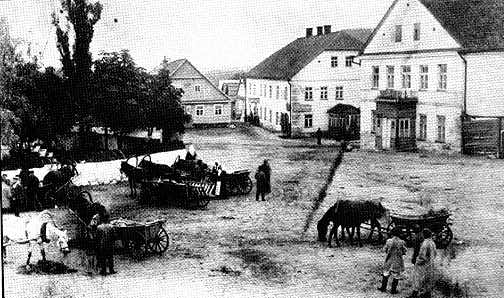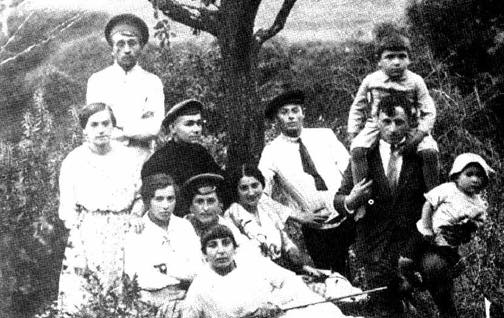
Meretch (Merkine in Lithuanian) lies in the South Eastern part of Lithuania, on the right bank of the river Nemunas, where the river Merkys and the small stream Stange flow into it. It is a very old urban settlement, where in the 14th century a fortress had already been built on a hill near the town, the remains of which still exist today, and the area was one of battles between the German Crusader Order, the Lithuanians and the Poles.
In 1387 the Lithuanian Great Duke Vytautas and the Polish King Jagelo (Jogaila) converted its residents to Christianity.
In 1576 King Zigmunt-August granted the town the Magdeburg Rights for self rule. At that time the exact site of the town was determined and four columns were erected at its four corners, two of which apparently still exist.
During the 17th an 18th centuries' wars, Meretch was badly damaged. In 1655 it was occupied by the Russians and totally burnt down. In 1707 Tzar Peter the First arrived in Meretch with his army, awaiting the Swedes. The Russians took horses, cattle and food products from the residents and burnt the rest, as a result of which many Meretch residents starved.
During the uprising of the Poles in 1794 led by Koschiusko, Meretch was again burnt down and ruined by the Russians.
In the 19th century, under Russian rule, the town was included in the Trakai district of the Vilna Gubernia, becoming an important commercial center because of its location at a junction of the important roads Kovno-Grodno and Vilna-Suvalk, and being situated along the water ways of the Nemunas and the Merkys.
In 1869 its population numbered 1,494 residents, and by 1882 - 2,148 residents lived there. The people of the town made their living from agriculture, fishing, mushroom drying and commerce.
In 1915, during WW I, Meretch was occupied by the Germans who ruled there till 1918, at which time the independent Lithuanian State was established. For a short while the town was occupied by the Bolsheviks, but in 1920 the Poles conquered it until they themselves retreated before the Lithuanian army.

Meretch Jews at forced labor during WW I
In the spring of 1921 a great fire broke out, burning down 100 houses and many farm buildings. The American Red Cross supplied the victims with 84 tons of food and garments.
During the period of independent Lithuania (1918-1940) Meretch was part of the Alytus district and a county center. In the twenties a central water supply system was built and it became one of the first towns of Lithuania to have such an installation. Later the town got electricity from one of its sawmills where a generator was installed.
During the German invasion of the USSR on June 22, 1941 the town was bombed and many buildings damaged. The Nazi rule with its terror and atrocities lasted until June 1944, when the Red Army reconquered Meretch. During the battles the center of the town was badly damaged.
Jewish Settlement till after World War I.
Society and Economy.
The beginnings of Jewish settlement in Meretch can apparently be traced back to the 15th century. A document from 1486 states that the Great Duke Kazimir ordered his clerks to demand that Yanka (Ya'akov) Yatzkovitz and his sons pay taxes. In documents dating from 1539 Meretch Jews are mentioned in connection with a conflict between a Jew named Koniuk and a Christian who owed him money. Documents from 1551 mention Meretch Jews in connection with their exemption from having to pay the special tax imposed on all urban and rural citizens.
During the years 1768-1772 Jewish workers were employed in excavating the Nemunas river between Meretch and Rumshishok (Rumsiskis), in order to improve its sailing conditions.
Meretch was included in the list of communities which were subordinated to the "Va'ad Medinath Lita" (The committee of the Jewish communities in Lithuania) (1623-1764), and was mentioned in the "Pinkas" (Notebook) during the years 1623-1761. In 1765 - 444 Jews resided here, and by 1847 the number had increased to 1565 Jewish residents.
The town was built in the form of a circle, the market square being in the center and around it the Jewish houses with their shops, vegetable and fruit gardens. Behind them were the Christian neighborhoods.

The Market Place
The Jews made their living from commerce and crafts, and Jewish merchants travelled on business to the bigger cities of Suvalk, Grodno and Vilna. Bezalel Manosovsky rented forest plots from the government for the purpose of felling trees, which were then transported on rafts on the Nemunas to Prussia. He also owned a sawmill and employed both Jewish and Christian workers. Jews owned flour mills, a brick factory, a leather factory, a workshop of candles and a few bakeries. Shoemakers, tailors, carpenters and builders could be found amongst the craftsmen.
At the end of the 19th century Meretch Jews settled in agricultural colonies which the Russian government provided free of charge on condition that they cultivate the land. In 1849 such a colony was established in Panasishok (Panosiskes) and ten families from Meretch settled there. Meretch Jews also settled in those colonies which were established in 1847 in Leipun (Leipalingis) and in Dukshna.
In 1884, on "Chol Hamoed" Succoth, a great fire razed 50 Jewish houses. In the Hebrew newspaper "HaMeilitz" of St.Petersburg dated the 20th of October 1884, an appeal for help for the victims of the fire was published, signed by the Rabbi of Meretch, Yehuda haLevi Lifshitz. In 1893 several fires broke out in the town, for which fifteen Jews were accused of arson, but the accusation was withdrawn. In 1897 a cholera epidemic raged through the town.
A bank established by the JCO (Jewish Colonization Organization) in 1907, initiated by Meretch Jews Yosef Ziman, Mendel-Gershon Yanilov and Avraham-Hertz Miler, played an important role in the economic life of the town.
Education and Religion.
Jewish children received their education in the "Cheder", in the "Talmud Torah" and in the government school established in 1853 on the initiative of the local intelligentia. There were two classes in the "Cheder" - the first one for learning to read the "Sidur", and the second one where "Gemara" and "Mishnah" were taught. There the children studied till "Bar-Mitzvah", thereafter the talented pupils continued their study in the "Yeshivoth" of Lida, Volozhin and Slabodka. There were six "Chadarim" for boys and one for girls. In the "Talmud-Torah" mainly "Sidur", "Chumash" and Hebrew were taught, without tuition fees.
In 1860 a Jewish government school was opened with four classes, boys and girls studying together, the teaching language being Russian. One of the teachers was Yosef-Eliezer Epstein, a student of the rabbinical school in Vilna. The pupils of the "Chadarim" were obliged to attend this school for several hours every day to in order to study Russian.
Shortly before WW1 a "Yeshivah Ketanah" (a small or elementary Yeshivah) was established, intended for boys of 13 years of age and upwards. The local Rabbi acted as the supervisor of this school.
Meretch boasted three synagogues, which played a central role in the spiritual and cultural life of the town's Jews. The "Shul", the "Klois" and the "Beth Midrash" lay in the same street and everyone of them had its own worshippers. The "Shul" was a beautiful building with an "Aron Kodesh" (Holy Ark) made from carved wood,
brass chandeliers hanging from the vaulted ceiling which was painted azure like the sky, with stars set in it. In the "Shul" prayers were held only on Saturdays and holidays. Guest cantors would appear and tickets would be sold for these appearances. The "Klois" was a great and lovely building too. "Gemara" (Talmud) learning took place in the "Beth Midrash". Many societies concerned themselves with adult study of Judaism: Shas, Mishnayoth, Tehilim, Tifereth Bachurim and Shulchan Aruch whose "Pinkas" from the years 1873-1898 was saved.
The "Haskalah" (Enlightenment) movement appeared in Meretch as well and the Jewish "intelligence" read the Hebrew books of Avraham Mapu, Peretz Smolenskin and others with great interest.

The "Intelligencia" in 1916
Zionist activity had started already in the eighties of the 19th century. In the summer of 1887 David Veiberg, a settler of Rishon LeZion, came to Meretch to visit his parents. He asked the public to donate for the "Chalutzim" in Eretz Israel, to which the public responded positively and donated generously, but the local Rabbi objected. Once, on a Shabbat eve, on seeing proclamations of the "Mizrachi" party (The religious Zionist party) in the Synagogue, he became very upset and on Shabbat night ripped them to pieces. In spite of this, Zionist activity continued and in 1898 a Zionist Association was founded.
Welfare institutions included "Hachnasath Orchim", "Bikur Cholim", "Linath haTsedek" and a ladies' association for social help.
There was a "Voluntary Fire Brigade", most of its members being Jews. During the years the heads of this brigade were Yehoshua David Manisovsky, Yisrael Tuviah Kubitzky, Binjamin Laukenitzky.
During all this period Jews immigrated to South Africa and mainly to America, many of them settling in New York and Boston. In Boston there existed (maybe even now) the "Meretch Relief Association" which supported the community in Lithuania and kept contact with the few Meretch Jews who had immigrated to Eretz Israel.
During WW I the Jews of Meretch remained in town, even absorbing refugees who were expelled from the Kovno Gubernia by the Russians.
The Rabbis who served in Meretch during this period were: Yitshak son of Zvi in 1835; David Volpe (---1884); Ben-Zion Shternfeld (1835-1914); Yehuda haLevi Lifshitz (1829-1905); Michal-David Shtupel (1865-1941) also served as head of the Yeshiva and murdered in the Holocaust. The Rabbis got a modest salary, but in addition had the exclusive yeast selling concession in town. All the women in town, including the Christian ones, would come to the Rabbis to buy yeast.